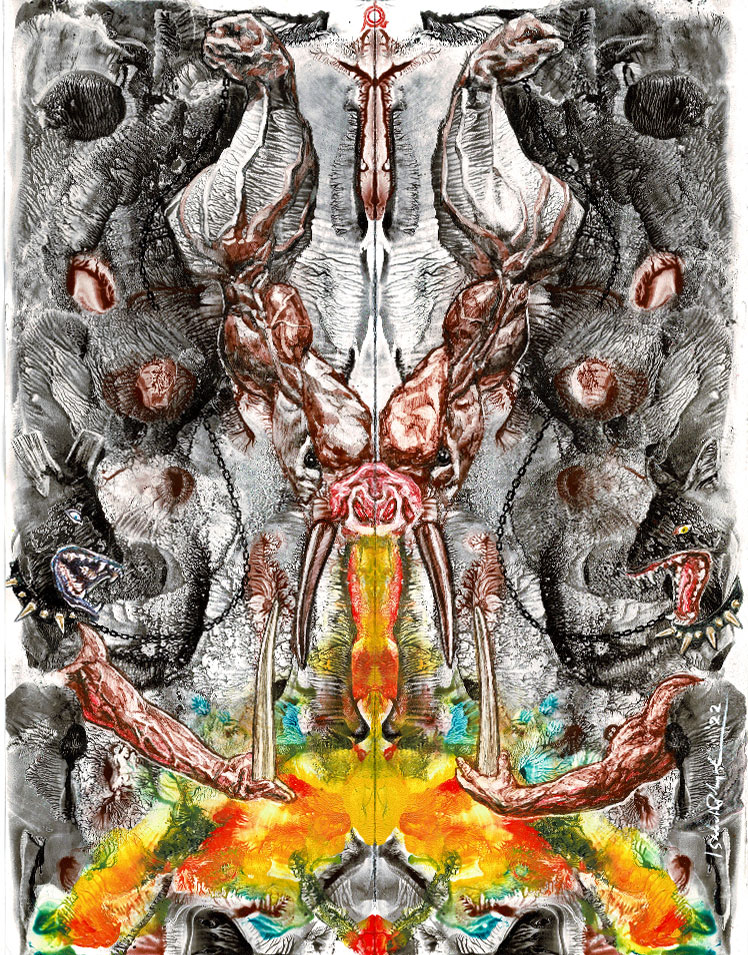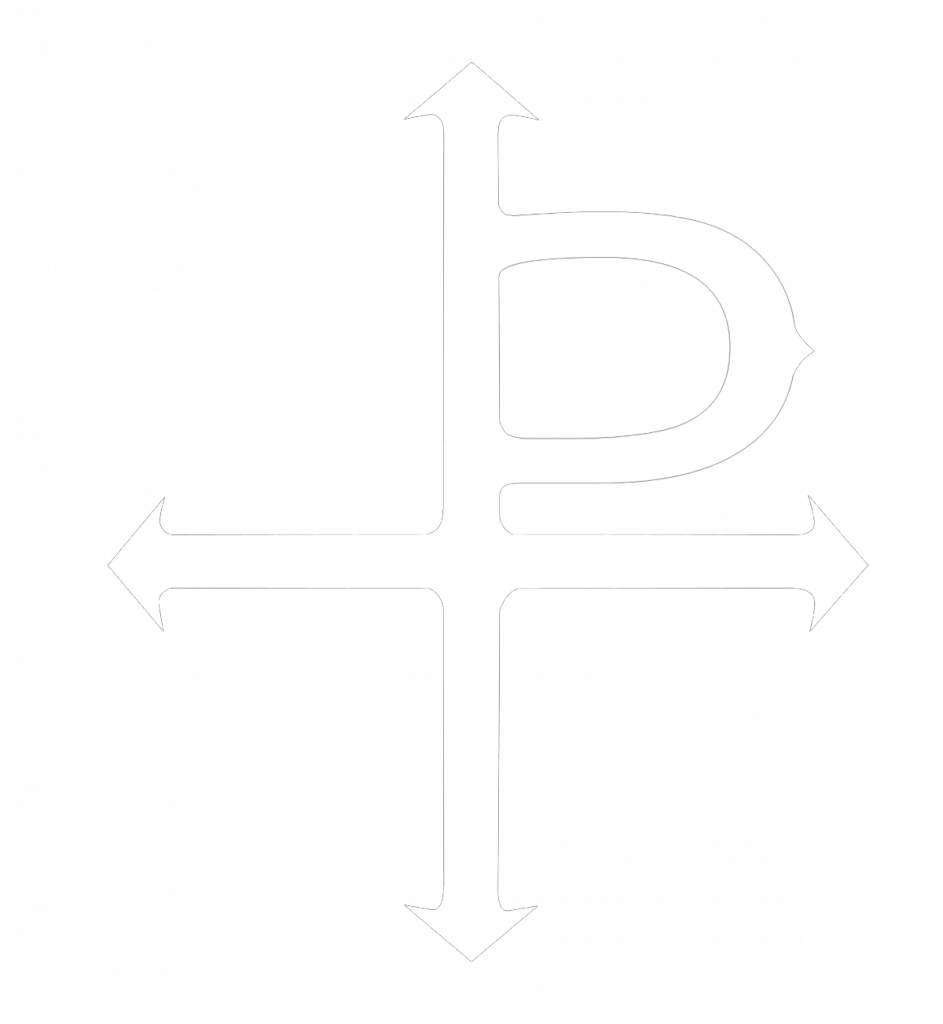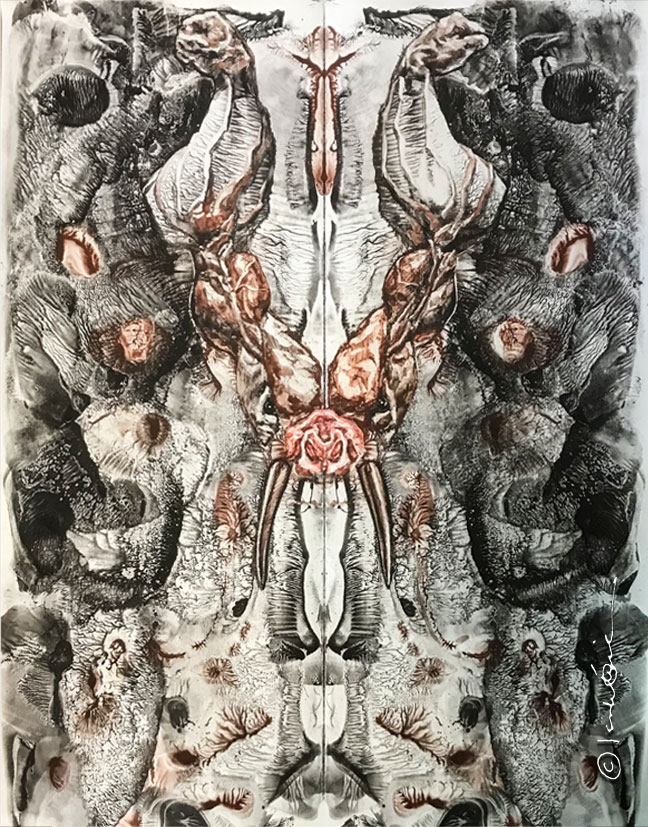
Watercolor
27.9 x 21.5 cm
2022
“Psychotechnics”, in my universe is the use of psychological techniques for controlling and modifying human behavior, especially for practical ends.
In choosing visual art as a career, one of my purposes is to make people snap out of their semi-conscious lives and consider other possibilities, even realities. It might not be easy to process, but it finds the right people.
Unfortunately I wasn’t able to document the unadulterated inkblot, but this painting started out like this…
It came to a point when I needed to do something crazy with it, like change the color scheme into something that didn’t fall under my aesthetic. To my standards, it ended up downright psychedelic, like a clown ate rainbow bread and vomited. Just looking at it now makes my eyes and brain hurt, but I also laugh a little bit.
Manipulating these Rorschach-like blots is stressful. First I make plenty of them until I find a “perfect” one to convey my idea. Then I have to destroy that perfect one to paint my message across. There is always a risk of creating something worse than the original unadulterated ink blot (which can already stand alone as a finished artwork). This is the antithesis of “If it ain’t broke, don’t fix it”. One has to be brave enough to alter something that is already self contained. “It looks cool, now destroy it to make something better”.
* * * * * * * * * * * *
The outcome of an artwork is greatly based on a duality between two kinds of vision. The first is a term is something I am coining: “Saccade’ic” after the word “saccade”, referring to the rapid movement of the eye(s) between fixation points. In short, “from the eyes”. The second is the traditional “Aspective” view, which captures the most recognizable aspects of things. In short, “from the brain”.
Hyper-realism and its sub-forms fall under the Saccade’ic category. One would say the goal is to capture something as if it were a photograph, or arguably as if it were right there in front of you. Saccade’ic work has a lot to do with accuracy, copying something line, per line, or even dot per dot. But to me, people shouldn’t aspire to become artists just to mimic photographs. A camera or a printer can do that and they don’t even have brains. However, working in a Saccade’ic manner is excellent practice. It is also an excellent way to initate understanding. E.g. for quite a long time I knew there was something missing in my work, and through Saccade’ic practice I noticed the diagonal lines that connected light and shadow (hence my “diagonal theory”). Saccade’ic work it is not the be-all-end-all, it is a means to an end. On the bright side, it’s easy on the eyes, easy on the brain, and you’ll probably sell more if you stay within this hemisphere.
The Aspective view might sound quite familiar, because it is most commonly associated with Egyptian Art. But, I’d like to take it a step further. Some of the most recognizable aspects of living on Earth are the laws of light and shadow on form. This is something very natural like gravity, and yet many “artists” fail to capture it because they’re too busy copying stuff. If one masters the way these natural laws work, then you’re free to give realism to anything, and it will appeal to the sensibilities of any human brain. In short, the work has “life”. And this is why a lot of the works based on photographs look kinda dead and stiff. (Hey I’ve been guilty of committing those crimes too).
A good artwork should have a balance between the Saccade-ic and the Aspective, just like how the Luciferic and Ahrimanic essences should balance each other out in Anthroposophy to create an optimal state. Another similar concept is the Egyptian “Ma’at”(harmony) where the collaboration of positive and negative form a whole. Ideally, the artwork should have enough Saccade-ic influence for the viewer to understand that the artist has accuracy, control over the material, discipline, but enough Aspective elements to take the viewer to another world/dimension/realm.. So the Saccade’ic makes the artwork credible, and the Aspective takes you to a new reality based on the foundations of this one. E.g. I want to paint a piece of cloth on a table. The Saccade-ic approach would be to copy every fold, light and shadow/color as accurately as possible. The Aspective take on it would be to copy the parts of the cloth that I like, and be free to change the lighting, even the color, add more creases, change the size of the cloth etc. But when a person sees both paintings, the one with creative alterations should look as realistic as the faithfully copied one.
* * * * * * * * * * * *
A monster can comprise multiple fragmented entities. It can be formed by parts of human consciousnesses that join forces because they are incapable of operating independently. It’s like the human version of “singularity” where together, “homonculi-ic” minds, “puttied” together by bookish interpretations of ideologies + name dropped institutions can gain enough momentum to create their own morality. It’s like John Carpenter’s Thing with epic proportions. There just isn’t enough fuel, or a flamethrower large enough.
And what is the real definition of “good” anyway? Well, to get there, let’s begin with the word “nice”. It’s a lukewarm, flaccid, pathetic, vague, zombie sewer that people like to spend their lives wallowing in. Nice has nothing to do with being good or doing the right thing. That’s why sometimes being good makes you a monster to society, because it takes courage not to be neutral.
This brings us to the Egyptian God, Set (also known as Seth, or Suetekh). Nobody is even certain about what animal he’s supposed to be. Initially worshiped as a protector, god of life, and love, Set eventually got promoted to becoming the Egyptian pantheon’s head villain. My theory is that it’s a simple matter of geography and politics, and this is quite an example of how morality can be manipulated by the consensus. But since the Ancient Egyptian philosophy is about balance anyway, In being bad, Set actually does good.
P.S. Anubis is also in da house.

